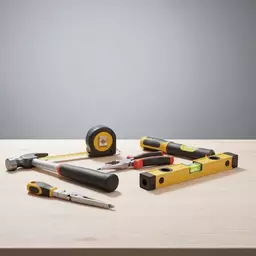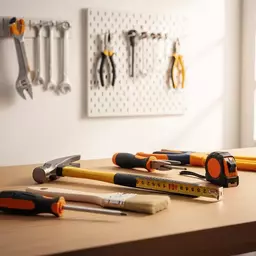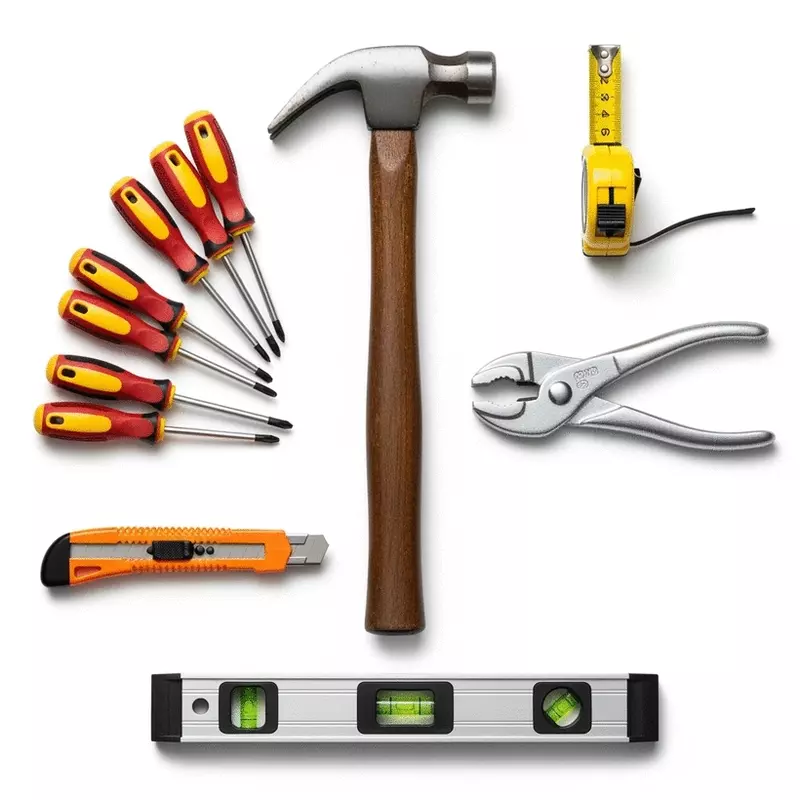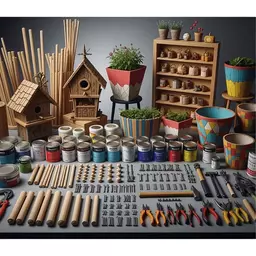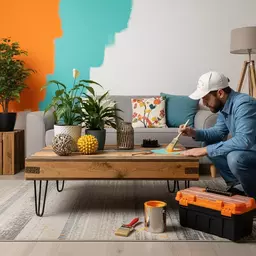Creative Home Repair Ideas for Beginners

Ready to transform your home without breaking the bank? DIY projects offer a fantastic way to unleash your creativity, save money, and develop skills that last a lifetime. With just a few tools and a bit of know-how, you can tackle home repairs that rejuvenate your space while boosting your confidence.
What You Will Learn
- DIY home repairs save money and offer a sense of accomplishment, turning challenges into triumphs.
- Personalized projects allow you to express creativity while enhancing your home's appeal.
- Essential tools like a measuring tape, hammer, and drill are crucial for successful DIY endeavors.
- Affordable alternatives such as borrowing or renting tools can ease the initial investment burden.
- Simple projects like painting and creating shelves can be both budget-friendly and satisfying.
- Safety gear is essential; prioritize protective equipment and workspace cleanliness to avoid accidents.
- Learning from mistakes is part of the DIY journey, and every project enhances your skills and confidence.
- Incorporating eco-friendly materials and practices contributes to sustainability while reducing costs.
- Connecting with local DIY communities can provide motivation and valuable tips for your projects.
- Documenting your DIY journey can inspire others and foster a sense of community among enthusiasts.
Cost Breakdown for DIY Home Repair Projects
Here’s a simple cost breakdown for common DIY home repair projects, allowing you to budget effectively. For more comprehensive insights into larger projects, check out our guide on DIY Home Renovation Tips Uncovered.
Painting a Room
Approx. $50-$100
DIY Shelving
Approx. $30-$60
Peel-and-Stick Backsplash
Approx. $40-$80
Creative Home Repair Projects: A Beginner's Guide
Getting started with home repairs can seem a bit scary, but it’s also a fantastic opportunity for creativity! At Hardware Store Guide, I love empowering you to tackle DIY projects with confidence. Whether you’re patching a wall or creating decor, embracing these projects can transform your living space while building your skills.
Understanding the importance of DIY home repairs is the first step. Not only do they save you money, but they also give you a sense of accomplishment. Plus, it’s amazing to see the results of your hard work right in front of you!
Understanding the Importance of DIY Home Repairs
Embracing DIY home repairs offers numerous benefits. Here are a few to consider:
- Cost savings: Performing your own repairs can significantly reduce labor costs.
- Personalization: You can tailor your projects to fit your style and needs.
- Skill development: Each project enhances your DIY abilities and general home maintenance knowledge.
Getting involved in home repairs isn’t just practical—it's liberating! You will develop a sense of pride as you learn to fix things around your house, turning potential challenges into triumphs.
The Benefits of Taking on Creative Home Repair Projects
One of the greatest joys of DIY is the chance to express your creativity. Projects like creating custom furniture or refreshing your paint colors can make a big difference in your home’s appearance.
Moreover, DIY projects instill a sense of empowerment. You’ll realize you can handle things that once seemed daunting. Imagine confidently tackling those little nagging repairs, feeling like a pro in your own home!
Building Skills and Confidence Through DIY
Building your skills doesn’t happen overnight. However, each project is a stepping stone to greater confidence. Start small: replace a light fixture or change cabinet handles, and you'll see how your confidence grows with each successful task! For more on essential tools to get started, explore our article on Essential DIY Tools for Homeowners.
At Hardware Store Guide, we encourage you to celebrate these victories, no matter how small. Share your experiences and learn from others in the DIY community; it can be incredibly motivating!
Essential Tools for Beginner Home Repair Projects
When diving into DIY, having the right tools is essential. A well-equipped toolkit can make your projects smoother and more enjoyable. Here’s a list of must-have tools for your DIY toolkit:
- Measuring tape
- Hammer
- Level
- Utility knife
- Drill and drill bits
- Basic set of screwdrivers
These essential tools can help you tackle a variety of projects. Plus, they help you feel prepared to take on anything that comes your way!
Must-Have Tools for Your DIY Toolkit
Let’s dig a little deeper into some of these essential tools:
- Measuring tape: Perfect for accurate measurements, an essential step in any project.
- Hammer: Useful for driving nails and assembling components.
- Drill: Ideal for creating holes and securing items.
Having these tools on hand makes it much easier to start and complete projects with efficiency.
Affordable Alternatives for Every Beginner
Don’t worry if the initial costs seem high; there are plenty of affordable alternatives out there. Here are some suggestions:
- Borrow tools from friends or neighbors.
- Consider renting tools for one-time projects.
- Shop at local hardware stores for sales or discounts.
Building your toolkit gradually is completely fine. Remember, it’s all about starting where you are and working your way up!
Power Tools vs. Hand Tools: Which Should You Choose?
As a beginner, you might wonder whether to invest in power tools or stick with hand tools. Both have their advantages. Here’s a quick overview:
- Power tools: They can save time and effort for larger projects.
- Hand tools: Often more affordable and easy to control for intricate work.
Ultimately, the choice depends on the types of projects you plan to tackle. Start with what feels most comfortable and gradually expand your toolkit as you gain confidence! For detailed information on specific tools, consider our article on Choosing the Right Drill for Repairs.
Budget-Friendly Creative Repair Projects
Now that you have a grasp on the importance of DIY and your toolkit, let’s explore budget-friendly projects. Home improvements don’t have to be expensive! Here are a few simple ideas:
- Freshen up a room with a new coat of paint.
- Create DIY shelving with reclaimed wood.
- Install peel-and-stick backsplash for a quick kitchen upgrade.
These projects are not only cost-effective but also allow for personalization and creativity!
Simple Aesthetic Upgrades Without Breaking the Bank
Simple upgrades can make a significant impact. Think about these easy ideas:
- Change cabinet handles or knobs for a fresh look.
- Add wall decals or artwork to brighten up your space.
- Rearrange furniture for a new perspective on your room.
These small adjustments can refresh your space without the hefty price tag, allowing for a fun DIY experience!
Cost Breakdown for Each Project Idea
To help you budget for your projects, here’s a simple cost breakdown:
| Project Idea | Estimated Cost |
|---|---|
| Painting a room | Approx. $50-$100 |
| DIY shelving | Approx. $30-$60 |
| Peel-and-stick backsplash | Approx. $40-$80 |
Keep in mind that these are estimates, and prices can vary based on materials and local hardware store pricing.
Budgeting Tips for Home Renovation Projects
Budgeting can be a breeze with these tips:
- Prioritize your projects based on necessity and impact.
- Set a clear budget before starting each project.
- Look for sales and discounts at local hardware stores.
Sticking to a budget helps you stay on track and allows for even more fun DIY adventures!
Step-by-Step Instructions for Easy Home Repairs
Now that you’re armed with knowledge and tools, let’s go through some easy repairs you can start today. Here are some quick guides for common projects:
- Fixing loose cabinet handles
- Minor drywall patching
- Creative painting techniques
- Furniture restoration for old pieces
Each of these projects adds a personal touch to your home and helps you practice your newly acquired skills!
Fixing Loose Cabinet Handles: A Quick Guide
First, check if the screws are loose. If they are, grab your screwdriver and tighten them. If the handles are still wobbly, consider replacing the screws or adding a bit of wood glue for extra support.
It’s a simple but effective task that can make a noticeable difference in your kitchen or bathroom!
Minor Drywall Patching: Tools and Techniques
For those little holes or dents in your walls, patching is an easy fix. Start by gathering supplies: drywall patch, joint compound, a putty knife, and sandpaper. Apply the patch, let it dry, then sand for a smooth finish. It’s amazing how fresh walls can uplift a room!
Don't forget to paint afterward for a seamless look! This project can be done in just a few hours.
Creative Painting Techniques for a Fresh Look
Painting is one of the most rewarding DIY projects! You can try techniques like sponging, stenciling, or even ombre effects. These creative options can add depth and personality to any room.
For an easy start, pick a small area, like an accent wall, to experiment with your chosen technique. You’ll be amazed at how a little creativity can transform your space!
Furniture Restoration: Breathing New Life into Old Pieces
Instead of throwing away old furniture, consider giving it a makeover! Start by sanding it down to remove the old finish. You can then paint or stain it to match your style. Adding new hardware can also give it a fresh look. This project is both environmentally friendly and rewarding!
With a little effort, old pieces can become stunning focal points in your home. To find more simple ideas, explore our Simple DIY Repair Tips.
Safety First: Tips for Beginner Home Repair Projects
As you jump into DIY, remember that safety is key! Always wear appropriate safety gear like gloves and goggles. Here are some tips to keep in mind:
- Read the instructions for all tools and materials carefully.
- Keep your workspace clean to avoid accidents.
- Take breaks to avoid fatigue—your safety comes first!
By prioritizing safety, you ensure that your DIY journey will be enjoyable and successful!
Essential Safety Gear and Precautions
Invest in basic safety gear to protect yourself while working on your projects. Here are some essentials:
- Safety goggles to protect your eyes from debris.
- Dust masks to avoid inhaling harmful particles.
- Work gloves to protect your hands while handling tools.
Having the right gear allows you to focus on your projects without worry!
Common Mistakes to Avoid as a Beginner
Even experienced DIYers make mistakes, but learning from them is key. Here are a few common pitfalls to watch out for:
- Skipping measurements can lead to costly errors.
- Not reading instructions can result in confusion.
- Rushing through projects might lead to safety issues.
Take your time, and remember that each mistake is a chance to learn!
Essential Safety Tips for Home Maintenance
In addition to personal safety, ensure your workspace is safe. Here are tips to keep in mind:
- Keep tools organized and out of reach of children.
- Store chemicals and hazardous materials securely.
- Inspect electrical outlets and cords for safety.
Maintaining a safe environment is crucial as you embark on your DIY journey!
Eco-Friendly and Sustainable Home Repair Ideas
As you explore DIY projects, consider incorporating eco-friendly practices. Not only is it good for the planet, but it can also save you money!
Using recycled materials is a fantastic way to get creative. Here are some ideas to inspire you:
- Repurpose old furniture into new creations.
- Use reclaimed wood for shelving or accent walls.
- Incorporate energy-efficient lighting to reduce costs.
These projects not only reduce waste but also give your home a unique flair!
Using Recycled Materials for Your Projects
Think of all the materials you already have at home that could be reused! For example, old glass jars make great storage containers, and wooden pallets can be transformed into furniture.
By being resourceful with recycled materials, you can create beautiful pieces that are both functional and uniquely yours!
Energy-Efficient Upgrades for Your Home
Upgrading your home to be more energy-efficient is a smart investment. Consider these options:
- Replace incandescent bulbs with LED lighting.
- Seal drafts around windows and doors.
- Install a programmable thermostat to save on heating and cooling costs.
These small changes can lead to lower energy bills and a more sustainable home.
Upcycling Ideas for Home Decor
Get creative with upcycling! You can turn old items into stylish decor:
- Transform an old ladder into a bookshelf.
- Repurpose tin cans as decorative planters.
- Create a gallery wall using repurposed picture frames.
There’s no limit to what you can create with a little imagination and effort!
Inspiring Before-and-After Case Studies
There’s nothing more motivating than seeing real-life transformations! Before-and-after examples can fuel your creativity and enthusiasm for DIY projects.
Consider these inspiring ideas:
- A dull living room revived with a fresh coat of paint and new furnishings.
- A cluttered garage reorganized into a functional workspace.
- A garden space enhanced with upcycled containers and greenery.
These transformations show that you can achieve remarkable results with creativity!
Real-Life Examples of Successful DIY Projects
Check out local DIY communities or social media for incredible before-and-after stories! You’ll be amazed at what others have achieved. It can spark your motivation and provide practical insights for your projects.
Remember, every project starts with just an idea. Seeing others succeed can encourage you to take the leap!
How Small Changes Lead to Big Impact
Sometimes, it’s the little changes that make the most significant difference. Revamping a single room or updating small details throughout your home can enhance your overall living space.
Focus on one area at a time, and you’ll be surprised at the cumulative effect of your efforts!
Room Makeover Transformations and Their Impact on Home Decor
Room makeovers can breathe new life into your home. Whether it’s a kitchen refresh or a living room update, the changes can inspire you to tackle more projects!
Don’t hesitate to document your process and share it with the Hardware Store Guide community. Your journey can motivate others to begin their DIY adventures!
Pro Tip
Did you know? One of the keys to successful DIY projects is planning! Take time to sketch out your project and list all the materials you'll need before you start. This will save you time and frustration during the actual work. Plus, it helps you visualize the end result, making the process even more exciting!
Encouraging Your DIY Journey
Starting your DIY adventure can be exciting yet overwhelming! At Hardware Store Guide, we understand that getting into home repairs might raise a few questions. That's why I’ve gathered some frequently asked questions to guide you along this journey. Don’t hesitate to reach out if you have more questions; we're here to support you every step of the way!
Frequently Asked Questions (FAQs)
- What are the benefits of DIY home repairs?
- DIY home repairs offer significant cost savings by reducing labor costs, allow for personalization to fit your style, and help develop valuable skills and confidence in home maintenance.
- What essential tools do beginners need for DIY projects?
- Beginners should have a measuring tape, hammer, level, utility knife, drill and drill bits, and a basic set of screwdrivers. These tools are versatile and crucial for many common projects.
- Are there affordable alternatives if I can't afford new tools?
- Yes, you can borrow tools from friends or neighbors, rent tools for one-time projects, or look for sales and discounts at local hardware stores. Building your toolkit gradually is a great approach.
- What are some budget-friendly DIY projects?
- Budget-friendly projects include painting a room, creating DIY shelving with reclaimed wood, installing peel-and-stick backsplash, changing cabinet handles, or adding wall decals. These can significantly enhance your home without major expenses.
- What safety precautions should I take when doing DIY repairs?
- Always wear appropriate safety gear such as gloves and goggles, read all tool and material instructions carefully, keep your workspace clean, and take breaks to avoid fatigue. Prioritizing safety ensures an enjoyable and successful DIY experience.
Frequently Asked Questions About Home Repair Projects
When you're just beginning, it's common to wonder what projects are suitable for your skill level. The best starter projects for beginners often include small, manageable tasks that can build your confidence. Here are some ideas:
- Fixing loose handles or knobs
- Creating a simple shelf
- Painting a room or furniture
- Installing new light fixtures
These projects can help you develop essential skills without feeling overwhelmed. Plus, they can have a big impact on your space!
What Are the Best Starter Projects for Beginners?
Choosing the right tools is just as important as selecting the right projects. To make your repairs smoother, start with these essential tools for your toolkit:
- A quality screwdriver set
- A versatile hammer
- A tape measure for accurate measurements
- A level to ensure everything is straight
These tools are the foundation of any DIY project and will serve you well as you expand your skills!
How Do I Choose the Right Tools for My Repairs?
If you’re looking for guidance, there are many resources online! Some of my favorite places to find DIY tutorials and videos include:
- YouTube for visual learning
- DIY blogs like Hardware Store Guide
- Online courses or workshops offered by local hardware stores
- Social media platforms, where many DIY enthusiasts share their projects
These sources can offer step-by-step instructions to help you get started!
Final Thoughts on Taking on Home Repair Projects
Embracing your creativity through DIY home repairs can be incredibly rewarding. Every project you tackle will teach you something new! Remember, mistakes are just part of the learning process; they often lead to unexpected and delightful outcomes.
As you embark on your DIY journey, I encourage you to start small and grow your skills over time. Celebrate your successes, no matter how minor they may seem. Each improvement contributes to your home's character!
Embracing Creativity and Learning Through DIY
Connecting with local artisans and attending community workshops can also enhance your learning experience. These interactions not only provide valuable insights but also foster a sense of belonging among fellow DIY enthusiasts. So, get involved in your community!
Call to Action: Join the Community of DIY Enthusiasts
At Hardware Store Guide, we believe in the power of sharing experiences. I invite you to share your projects with others; your success stories could inspire someone else to take on their own DIY challenge!
Don’t forget to subscribe to our blog for more DIY tips and creative ideas. Let’s explore the world of home improvement together!
And if you're looking for inspiration, follow the latest DIY trends on Pinterest and various blogs. The possibilities are endless, and your next project could be just a click away! For more budget-friendly ideas, check out our guide on Budget-Friendly DIY Home Upgrades.
Recap of Key Points
Here is a quick recap of the important points discussed in the article:
- DIY home repairs save money while providing a sense of accomplishment and personalization.
- Starting small, such as fixing loose cabinet handles or painting, builds confidence and skills.
- Essential tools for beginners include a measuring tape, hammer, drill, and a basic set of screwdrivers.
- Budget-friendly projects like painting, DIY shelving, and peel-and-stick backsplashes enhance your home without high costs.
- Safety is paramount; always use appropriate gear and follow safety guidelines while working on projects.
- Incorporating eco-friendly practices, such as using recycled materials, reduces waste and enhances creativity.
- Engage with the DIY community for inspiration and support as you embark on your projects.
